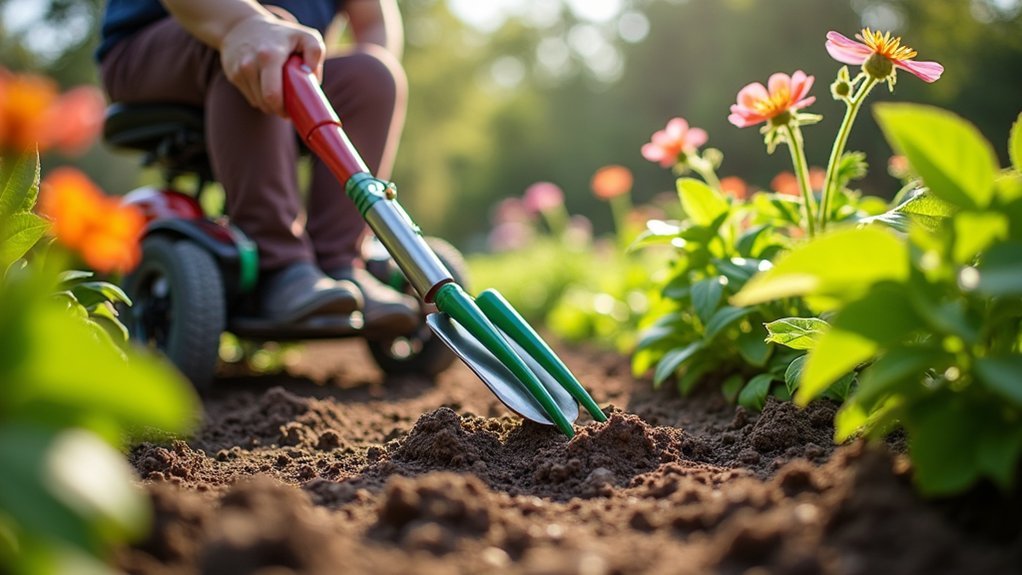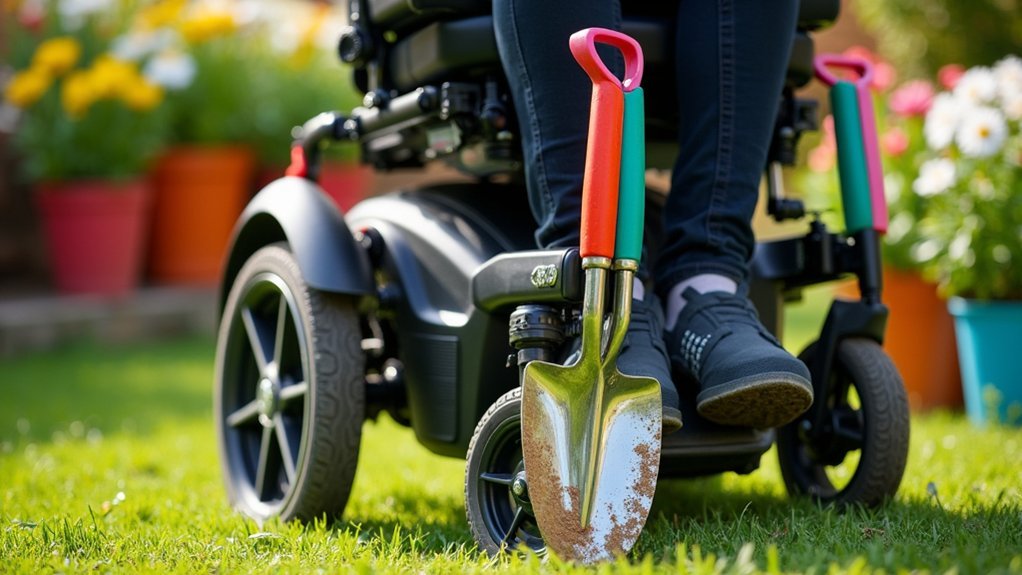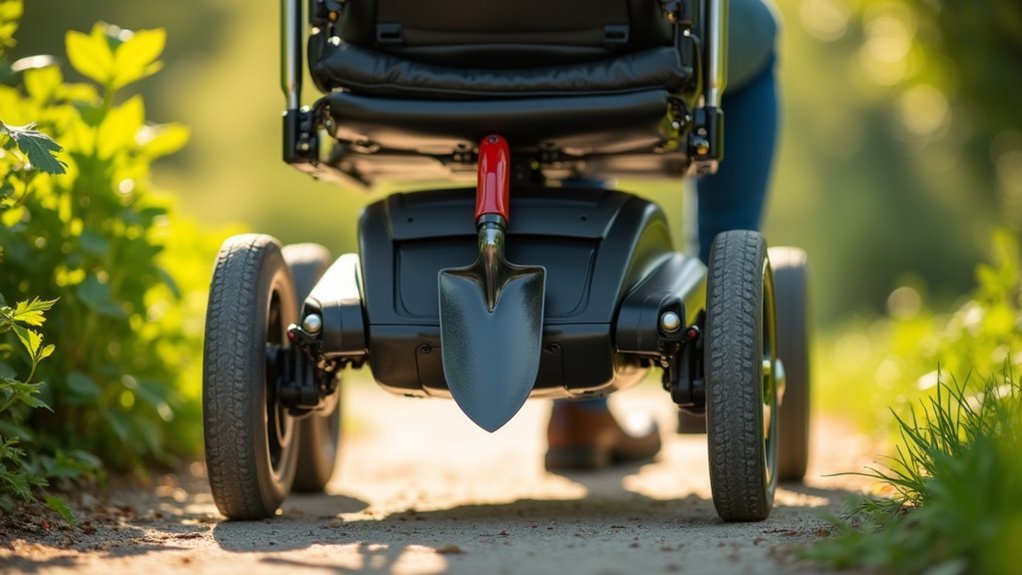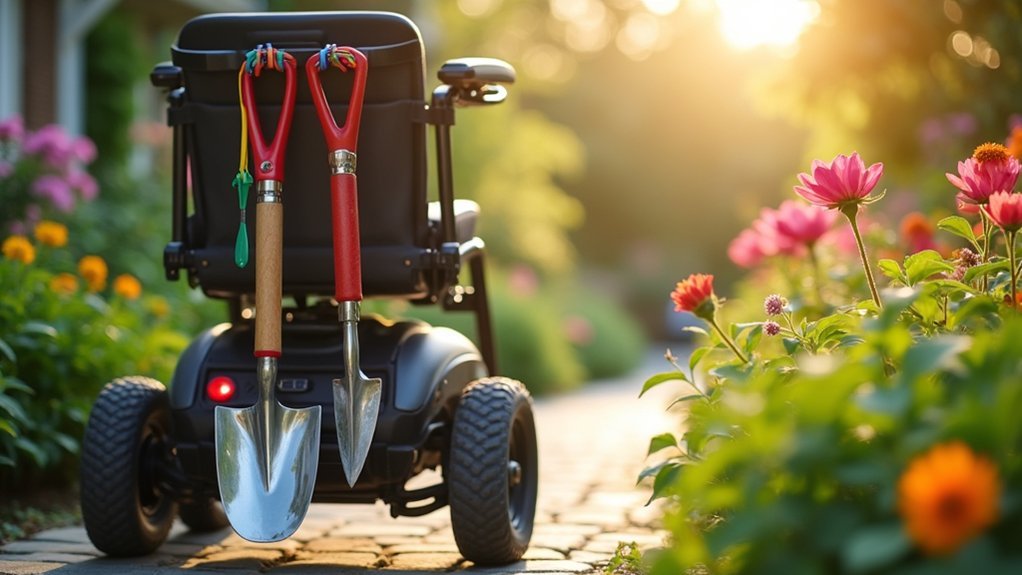Attaching garden tools to mobility devices lets you garden without leaving your wheelchair or scooter, promoting independence and self-sufficiency. You’ll experience less physical strain without bending or kneeling, while ergonomic adaptations minimize joint stress. These customizable attachments offer therapeutic benefits, building muscle strength and reducing stress while reconnecting you with nature. Innovative designs like quick-release mechanisms and multi-functional tools make gardening more accessible. Discover how these integrations can transform your gardening experience.
Enhanced Independence Through Accessible Gardening

While gardening has long been a beloved pastime for many, those using mobility devices often face considerable barriers to participation. By attaching gardening tools directly to your wheelchair or scooter, you’ll experience newfound freedom and self-sufficiency in the garden.
You’ll no longer need to constantly shift positions or ask for help reaching implements. These adaptations allow you to remain comfortably seated while maintaining continuous engagement with planting and cultivation activities. The ability to manipulate garden tools independently bolsters your confidence and preserves your sense of identity. Raised garden boxes eliminate the need for kneeling or bending over, further reducing physical strain during gardening activities.
This accessibility extends beyond practical benefits—it reconnects you with nature and reduces isolation through increased outdoor activity and social interaction. When you can garden on your own terms, you’ll maintain personal autonomy despite physical limitations, contributing considerably to your overall well-being.
Reducing Physical Strain While Maximizing Mobility
Gardening with mobility devices requires more than just tool attachments—it demands strategies to minimize physical strain.
You’ll find significant relief using ergonomic tools with padded handles that reduce wrist and joint stress during planting and weeding tasks.
Consider investing in lightweight equipment and collapsible wheelbarrows that won’t tax your strength when maneuvering garden terrain. Working during optimal times of day can significantly increase your endurance and overall gardening productivity.
Lightweight tools and foldable garden equipment preserve your energy and make navigating your garden sanctuary significantly easier.
Raised beds positioned at wheelchair height eliminate unnecessary bending, while swivel seat scooters let you work comfortably without frequent position changes.
Don’t overlook comfort enhancements like high-quality gripping gloves that protect your hands while increasing dexterity.
A carpenter’s apron keeps tools within easy reach, reducing repetitive bending.
For maximum accessibility, create wide pathways that accommodate your mobility device and position customized raised beds for effortless planting, watering, and harvesting.
Customizable Attachments for Various Mobility Devices

Customizable attachments transform standard garden tools into accessibility powerhouses for mobility device users.
You’ll find a variety of options—from trowels and cultivators to hoes—that can be secured to your wheelchair or scooter using adjustable clamps and secure fasteners.
These mounting systems feature lightweight materials to avoid adding unnecessary bulk while maintaining stability during use. You can adjust the height and angle to suit your specific needs, ensuring comfortable access regardless of your seating position.
Look for tools with ergonomic handles and cushioned grips that reduce wrist strain. Many attachments include anti-skid materials and angled heads for improved leverage. Consider attachments with extended reach capabilities similar to those offered in specialized garden tools.
Smart mounting systems allow quick tool changes as you move through different gardening tasks, while extendable options let you reach further without straining.
Therapeutic Benefits of Integrated Gardening Systems
Beyond their practical function, integrated gardening systems offer remarkable therapeutic benefits for users of mobility devices. When you engage in gardening activities using these specialized tools, you’ll experience improvements in both physical and mental well-being.
- Physical Health – You’ll build muscle strength, enhance coordination, and potentially reduce pain through engaging movements like digging and planting.
- Psychological Wellness – Your stress levels may decrease while your mood improves, creating a more peaceful mental state. These gardening adaptations create sensory-rich environments that can significantly enhance mood and cognitive function.
- Social Connections – You’ll gain opportunities to interact with others, fostering community and expanding your support network.
- Sustained Engagement – The accessibility of these integrated systems guarantees you can participate fully in gardening activities, maintaining therapeutic benefits over time.
Innovative Designs for Seamless Tool Integration

While traditional gardening tools present significant challenges for mobility device users, today’s innovative designs are revolutionizing accessibility through seamless integration.
Modular attachments now securely mount to wheelchair frames, eliminating the need for constant reaching or bending.
You’ll find quick-release mechanisms that allow for effortless tool swapping while lightweight materials like aluminum keep the overall load manageable.
Multi-functional adaptations combine several tools into one attachment—think pruners with detachable hoes—saving valuable space.
Safety features include shock-absorbing mounts that reduce vibration and secure fastening systems that prevent accidental displacement.
For tech enthusiasts, smart integrations offer voice-activated commands and app connectivity for irrigation control directly from your mobility device.
These thoughtfully designed systems maintain proper balance and center of gravity, ensuring both functionality and safety.
Many users find that these integrated tools provide a therapeutic gardening experience that improves both mental health and physical wellbeing while accommodating their specific needs.
Frequently Asked Questions
How Much Weight Can Mobility Device Tool Attachments Safely Support?
Tool attachments for your mobility device can typically support 5-15 pounds, but you’ll need to make certain you don’t exceed your device’s total weight capacity, which ranges from 250-700 pounds depending on model.
Are Weatherproof Options Available for Tool Attachments?
Yes, you’ll find plenty of weatherproof options for tool attachments. They’re typically made from stainless steel, durable plastics, and feature protective covers, waterproof bags, rubberized handles, and powder coating to withstand outdoor elements.
Can Attachments Be Installed Without Professional Help?
Yes, you can install most mobility device attachments yourself. Many use simple clamps, straps, or quick-release mechanisms designed for easy DIY installation without special tools or expertise. Just follow the included instructions carefully.
How Do I Prevent Soil Contamination of My Mobility Device?
Use mobility device wheel covers, clean wheels after gardening, create pathways with mulch or gravel, and use raised beds with barriers. You’ll also want to avoid heavily contaminated areas and regularly wipe down your device.
Do Medicare or Insurance Plans Cover Gardening Mobility Attachments?
Medicare typically doesn’t cover gardening-specific attachments unless they’re medically necessary for mobility. You’ll need documentation from your healthcare provider. Check with your specific plan as private insurance coverage varies widely.
In Summary
Attaching garden tools to your mobility device isn’t just clever engineering—it’s freedom. You’ll garden with dignity and independence while protecting your body from strain. The customizable attachments work with your specific mobility needs, transforming gardening from frustrating to therapeutic. These innovations mean you don’t have to choose between mobility assistance and your passion for plants. You can have both, seamlessly integrated into your daily life.





Leave a Reply